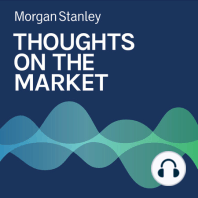3 min listen

Matt Hornbach: Key Currency Trends for 2023
Matt Hornbach: Key Currency Trends for 2023
ratings:
Length:
4 minutes
Released:
Dec 6, 2022
Format:
Podcast episode
Description
As bond markets appear to have already priced in what central banks will likely do in 2023, how will this path impact inflation and currencies around the world?----- Transcript -----Welcome to Thoughts on the Market. I'm Matthew Hornbach, Morgan Stanley's Global Head of Macro Strategy. Along with my colleagues, bringing you a variety of perspectives, today I'll talk about our 2023 outlook and how investors should view some key macro trends. It's Tuesday, December 6th, at 10 a.m. in New York. During the pandemic in 2020 and 2021, central banks provided the global economy a safety net with uber-accommodative interest rate and balance sheet policies. In 2022, central banks started to aggressively pull away that safety net. In 2023, we expect central banks to finish the job. And in 2024, central banks will likely start to roll out that safety net again, namely by lowering interest rates. Bond markets, which are forward looking discounting machines, are already pricing in the final stages of what central banks will likely do in 2023. The prospect of easier central bank policies should bring with it newfound demand for long term government bonds, just at a time when supply of these bonds is falling from decade long highs seen in 2021 and 2022. Central bank balance sheets will continue to shrink in 2023, meaning central banks are not aggressively buying bonds - but investors shouldn't be intimidated. These expected reductions in central bank purchases are already well understood by market participants and largely in the price already. In addition, for the largest central bank balance sheets, the reductions we forecast simply take them back to the pre-pandemic trend. Of course, for central bank policies and macro markets alike, the path of inflation and associated expectations will exert the most influence. We think inflation will fall faster than investors expect, even if it doesn't stabilize at or below pre-pandemic run rates. Lower inflation around the world should allow central banks to stop their policy tightening cycles. As lower U.S. inflation brings a less hawkish Fed to bear, the markets should price lower policy rates and a weaker U.S. dollar. Lower inflation in Europe and the U.K. should encourage a less hawkish ECB and Bank of England. This should help growth expectations rebound in those vicinities as rates fall, which will result in euro and sterling currency strength. We do think the U.S. dollar has already peaked and will decline through 2023. A fall in the U.S. dollar is usually something that reflects, and also contributes to, positive outcomes in the global economy. Typically, the U.S. dollar falls during periods of rising global growth and rising global growth expectations. As we anticipate the dollar's decline through 2023, it's worth noting that in emerging markets, U.S. dollar weakness and EM currency strength actually tend to loosen financial conditions within emerging market economies, not tighten them. Emerging markets that have U.S. dollar debt will also see their debt to GDP ratios fall as their currencies rise, further helping to lower borrowing costs and, in turn, boosting growth. In a nutshell, we see the negative feedback loops that were in place in 2022 reversing, at least somewhat in 2023 via virtuous cycles led by lower U.S. inflation, lower U.S. interest rates, and a weaker U.S. dollar. Thanks for listening. If you enjoy Thoughts on the Market, please take a moment to rate and review us on the Apple Podcasts app. It helps more people find the show.
Released:
Dec 6, 2022
Format:
Podcast episode
Titles in the series (100)
Mike Wilson: How Confident Are U.S. Businesses in the Economy? by Thoughts on the Market